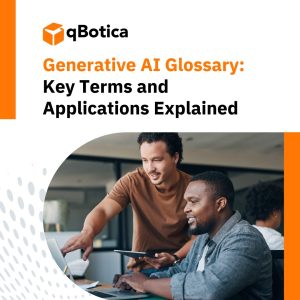In the ever-changing landscape of technology, Chief Information Officers (CIOs) have a critical role in guiding organizations towards innovation and efficiency. With the emergence of Generative Artificial Intelligence (GenAI), their duties have expanded to embrace the transformative capability of AI.
This article delves into how CIOs are embracing the art of the possible in this GenAI adventure. From comprehending the GenAI landscape to leading AI implementations and conquering challenges, CIOs are at the forefront of propelling organizational success.
The CIO’s Outlook on GenAI
The CIO’s perspective on GenAI is multifaceted, mirroring both the potential and difficulties related to its adoption. CIOs can use GenAI for software development to reduce expenses and accelerate innovation, thereby generating value for their organizations.
Adopting GenAI is not just an option but a strategic necessity, as it has the potential to reinvent the parameters of what is feasible in the IT landscape.
However, there is a conservative stance among CIOs regarding the adoption of Generative AI, and they need to cultivate essential skills and spearhead embracing the possibilities offered by GenAI.
Overcoming Obstacles and Apprehension
1. Understanding the Risks and Uncertainty
Businesses and organizational leaders face the test of comprehending the risks and uncertainties linked to implementing generative AI. As per a report by MIT Technology Review Insights, 59% of employers cite grasping the risks as a main challenge, indicating a need for extensive risk evaluation and mitigation tactics.
The ambiguity around regulation and engaging with regulators also adds to the apprehension, underlining the value of lucidity in the regulatory environment to alleviate fears and enable informed decision-making.
2. Education and Skill Building
Tackling the fear and difficulties associated with generative AI necessitates a concerted attempt in education and skill development. As with any technological progression, educating the workforce is paramount to mitigate fears and outfit individuals with the required competencies to leverage the potential of AI.
This comprises integrating AI literacy into educational curricula and furnishing training and upskilling opportunities for employees to enhance their comprehension and proficiency in utilizing generative AI tools.
3. Surmounting Resistance and Embracing Innovation
The anxiety of automation and job displacement is a prevalent concern linked to AI adoption. However, business leaders need to redirect the emphasis from resistance to embracing the potential of generative AI.
While there may be uncertainties, experts stress that AI can democratize technical skills across the workforce, resulting in new job prospects.
By promoting a culture of innovation and accentuating the transformative capability of AI, organizations can triumph over fear and resistance, paving the way for the accountable and beneficial implementation of generative AI.
The Role of Digital Culture and Innovation
1. Fostering a Culture of Innovation
A culture of innovation is fundamental to the successful deployment of GenAI. It encourages a mindset of continuous learning and experimentation, engendering a fertile environment for companies to evolve, adapt, and flourish in the competitive digital landscape.
This culture promotes risk-taking, continuous learning, and adaptability, maximizing the potential of generative AI to impel innovation, problem-solving, and transformation within diverse industries.
2. Breaking Down Silos and Constructing a Digital Culture
Embracing digital culture entails dismantling silos and fostering collaboration across different functions. It involves generating an environment that motivates creativity, experimentation, and continuous learning, which are vital for efficiently leveraging generative AI. By adopting a digital culture, organizations can harness the potential of GenAI to drive innovation and problem-solving.
3. The Link Between Innovation and GenAI
Innovative cultures provide a significant edge in the adoption of generative AI. Companies with innovative cultures are better positioned to deploy GenAI effectively, as they prioritize vision, strategy, and the pursuit of new and bigger ideas grounded in differentiated business insights.
This connection between innovation and GenAI engenders a symbiotic relationship, where innovation encourages the apt utilization of GenAI, and in turn, GenAI fuels further innovation.
4. The Impact on Culture and Society
Generative AI’s impact transcends the technology domain, influencing cultural, social, and economic spheres. By democratizing the creation of art and unveiling new artistic frontiers, GenAI is challenging conventional norms and disrupting various creative industries.
This underscores the profound influence of GenAI on culture and the importance of fostering a digital culture that can adapt to and leverage these transformative shifts.
Looking Ahead: The Adventure of a Lifetime
As we look ahead to the future of generative AI (GenAI) adoption by CIOs, it is evident that embracing this technology is a strategic necessity. According to a CIO who has witnessed the transformative power of GenAI firsthand, it has the potential to not only assist but also reinvent the parameters of what is feasible.
However, adopting GenAI necessitates conquering challenges and fears, including comprehending the risks and uncertainties, education and skill building, and surmounting resistance to change.
Cultivating a digital culture and innovation is also indispensable to the successful deployment of GenAI, as it promotes a mindset of continuous learning and experimentation.
Looking ahead, the soaring adoption of GenAI by CIOs in the next 4-5 years is anticipated, and technology leaders must spearhead the GenAI journey with confidence.
Conclusion
CIOs have a pivotal role in steering organizational success in the age of generative AI. By embracing the art of the possible, overcoming obstacles, fostering digital culture and innovation, CIOs can unleash the transformative power of GenAI.
As we stand at the cusp of a new era of possibilities, technology leaders must chart the course ahead with vision and purpose. The onus is on CIOs to fully harness the potential of GenAI to drive value, growth and competitive advantage for their organizations, while mitigating risks and challenges. With the right strategy and mindset, this GenAI adventure promises to be the journey of a lifetime for technology leaders.
Ready to embark on this transformative journey? Contact with qBotica to explore cutting-edge solutions and insights to elevate your organization’s GenAI capabilities today!




